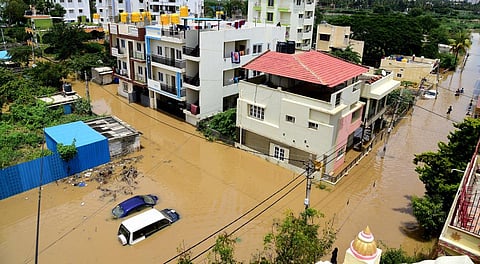

Climate change and rapid, unplanned urbanization are converging in dangerous ways, resulting in two diametrically opposed but equally acute urban woes threatening Bengaluru: flooding and water scarcity. This was amplified in 2022 when the city experienced unprecedented flooding and disaster relief personnel had to be pressed into service to evacuate people trapped in their homes in some suburbs. At the same time, there was a Ground Report to say that Bengaluru was among 30 Indian cities that would face a grave water risk by 2050.
The city’s urban area has increased 10-fold in the last 50-odd years, making Bengaluru India’s fourth largest city. Consequently, lakes have dwindled from around 280 in the 1960s to a mere 80 today. The complex interaction of land use changes with local ecosystems, hydrologic cycles, and atmospheric circulation have modified the city’s micro-climate. While rainfall intensity in Bengaluru has increased, most of the water is lost as runoff because of shrinking open spaces and disruption in stormwater drains network. Therefore, flooding has become common.
Changing weather patterns, accompanied by encroachment and pollution of the city’s lakes, have spelled doom for the delicate relationship between Bengaluru’s lake-dependent communities and the water bodies that once nourished and sustained them.
What made Bengaluru remarkable is that it was not built on the banks of a major river. Nor was it connected to any major perennial water sources. The city depended instead on an interconnected system of tanks or lakes that harvested rainwater. The naturally undulating terrain allowed excess rainwater from lakes at a higher elevation to overflow into the lakes below through an ingenious network of stormwater channels or raja kaluves. As these lakes were rain-fed and mostly seasonal, they operated in tandem with open wells, providing water to the city’s many residents. In fact, this lake system was able to meet the city’s entire water requirements even as late as the 1960s.
IN TROUBLED WATERS
Bengaluru is staring at an acute water crisis within the next decade. Currently, the demand for water for human consumption exceeds 2,100 million litres per day (MLD). Of this, ~1,470 MLD is supplied from the Cauvery River through the efforts of the Bangalore Water Supply and Sewerage Board (BWSSB). The deficit of 630 MLD is met through borewells and water tanker deliveries. By 2031, water demand is projected to jump to 5,340 MLD in the city to serve a projected population of over 20 million. Of this, 3,920 MLD will be needed for domestic use, according to the Revised Master Plan 2031 for Bengaluru.
The looming crisis calls for more inventive and currently unconventional methods of utilising water more effectively to safeguard the city’s future against the adverse impacts of a changing climate and dwindling water supply.
LEVERAGING WASTEWATER
Wastewater can be classified into two categories: blackwater and greywater. While greywater comes from kitchen sinks, showers, and bathtubs, blackwater comes from toilets and sewers that carry human waste. As they have different levels of contamination, they must be treated differently. But once treated, wastewater can be purified and turned into drinking water, or used for agriculture, municipal water supply, industrial processes, and environmental restoration.
Although wastewater reuse is an established practice in various countries, it remains relatively underdeveloped in India. Inadequate underground sewage systems for transporting wastewater and a scarcity of Sewage Treatment Plants (STPs) limit our country’s capability to treat sewage. Only India’s largest cities have centralized sewage systems, complete with underground pipes, pumping stations, and STPs. As a result, India treats a little more than a third of the sewage generated per day, according to the Central Pollution Control Board (CPCB). Bengaluru generates 1,480 MLD of wastewater of which only 75% is collected and treated.
Local recycling of greywater can considerably reduce the load on the public sewage system and bring down freshwater consumption. If the Bruhat Bengaluru Mahanagara Palike (BBMP) can ask citizens to process segregated waste within their premises, they can also mandate local treatment of greywater.
The BWSSB targets to capture 100% of the wastewater generated in the city by 2025, and the BWSSB Vision Document 2050 talks about “advanced treatment technologies” for recycling wastewater to produce “high-quality water that exceeds drinking water standards.”
REVISIT INDUSTRY REGULATIONS
To “reimagine wastewater as a water resource”, as articulated in the 2050 Vision Document, we not only need technological advancements but also a comprehensive shift in industrial regulations regarding processed wastewater.
Acute water shortage in many areas of Karnataka is already hampering industrial production. By 2030, the state’s industrial sector is projected to face a 69% gap between water demand and supply, according to Karnataka’s Urban Wastewater Reuse Policy 2017.
The current policy prescribes water quality requirements for use in boilers, as cooling water, and for industrial processes in the pulp & paper, textiles, and petroleum & coal industries.
There is an urgent need to revisit existing regulations and policies on the acceptability of recycled wastewater in the processes of a wider category of industries. For instance, Singapore employs advanced treatment processes that yield treated water comparable in quality to fresh water from natural sources, which is then used in industries.
The biotechnology and pharmaceuticals sector, which relies heavily on substantial water supplies, stands to benefit significantly from such changes.
Technology has a key role in converting wastewater into high-quality potable water fit for use as drinking water as well as processed industrial water.
By enabling the utilization of recycled wastewater in critical industrial processes, regulations can play a crucial role in fostering sustainability, diminishing strain on freshwater reserves, and charting a course toward more prudent water management practices.
Establishing a resilient and efficient wastewater management system can go a long way in improving the liveability of Bengaluru and making it a model of sustainability for the rest of the country to emulate.